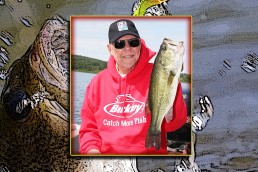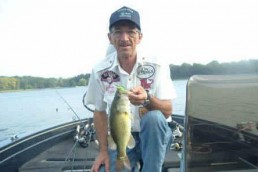Points, Inside Turns on Deep Weedlines keys for Summer Bass
SHARE THIS POST
When it comes to targeting summertime bass, there are truly a multitude of methods and strategies that will catch fish. These strategies vary from angler to angler and will cater to the demands of working a particular type of bass-holding structure.
I have certainly been successful at finding and catching largemouth in a wide variety of aquatic habitat. However, if there is one summertime pattern I lean on for consistent results and impressive numbers, it would have to be the deep weedline pattern.
The initial strategy for successful deep weedline angling is knowing your lakes. Not all lakes have a suitable deep weedline that will work for targeting largemouth. Depending on the body of water, the weedline may be too sporadic or too shallow to attract and hold numbers of bass.
Typically, the lakes that work well for me have weedlines that run in the 12- to 18-foot range. Weedlines that run deeper than 18 feet are generally found in very clear bodies of water and can make for tougher fishing. It takes a long time to drop a jig into 20 feet of water. I usually find these ultra-clear lakes have very small bass, anyway.
It is important to note that fish are not found everywhere along a deep weedline. Although scattered individuals may be caught in many locations, more substantial structure is required to really have schooling fish appeal.
Looking for deep weed structure isn’t much different for bass than it is for walleye angling. Fish love to relate to areas in their habitat that are different from the surroundings. This means points, inside turns, sunken islands and the like are going to be the places that hold the best concentrations of largemouth.
When I start to pick apart a new lake, I target the most pronounced points and structure areas first. From there I will move to more subtle structure.
The type of vegetation found in deep water plays a critical role in fishing success. Cabbage is the number one fish-holding vegetation. Bass love this weed and I will target it whenever and wherever I find it.
Are you enjoying this post?
You can be among the first to get the latest info on where to go, what to use and how to use it!
A couple of lakes I work in the summer have developed a soft, sand grass type of weed that flourishes in certain parts of the lake. Because this plant is nearly impossible to fish through without fouling the lure, I avoid these areas.
There are a number of lures that work well for deep weedline bass angling. I certainly have my favorites.
My number one search lure for deep weeds bass is the jigworm fished on 14-pound-test FireLine. Although not entirely weedless, I can work this jig through some mighty thick vegetation without much trouble.
The exposed hook on the jigworm works to my advantage. I get more hook-ups with this than anything else I fish. I prefer 1/8- to 1/4-ounce jigs, depending on the depth I am fishing. A PowerBait Shaky Worm is my favorite plastic for tipping.
Texas-rigged worms also work great for deep weedline angling. If I am struggling with hang-ups on my jigworm, I will instantly switch to a Texas rig with a 7-inch PowerBait worm or a weedless skirted jig.
The deep weedline is the interstate of the underwater world. It is a major travel edge and congregates fish activity, especially bass.
If I am going to spend a day on the water during the summer months, you can be sure much of my time will be spent targeting bass on the deep weedline.
MWO
SHARE THIS POST
Did you enjoy this post?
You can be among the first to get the latest info on where to go, what to use and how to use it!
Jerry Carlson
Jerry Carlson began his writing career in 1987 and covers both hunting and fishing topics. He currently writes for numerous media outlets and does radio work with WJON AM in St. Cloud, Minn. He has authored a book called Details for Locating and Catching Fish.



